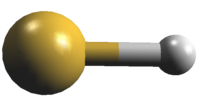Sulfoniumylidene, sulfanylium, X 3Σ–, 34S isotopolog
 | |
|---|---|
| Species tag | 035504 |
| Version | 1* |
| Date of Entry | Oct. 2017 |
| Contributor | H. S. P. Müller |
|
No rotational data are available at present for
34SH+. The transition frequencies
were evaluated from an isotopic invariant fit with data
from version 4 of the main species. Because of the
necessary neglect of parameters describing the breakdown
of the Born-Oppenheimer approximation, predictions were
limited to the N = 1 – 0 transition;
these are likely the only transitions observable in astronomical
sources. The position of each fine structure component is
uncertain to 1 or 2 MHz, potentially more. The uncertainties
of the hyperfine splittings within one fine structure component
are approximately correct. Further details are
given in | |
| Lines Listed | 9 |
| Frequency / GHz | < 683 |
| Max. J | 2 |
| log STR0 | -8.0 |
| log STR1 | -8.0 |
| Isotope Corr. | -1.377 |
| Egy / (cm–1) | 0.0 |
| µa / D | 1.285 |
| µb / D | |
| µc / D | |
| A / MHz | |
| B / MHz | 273323. |
| C / MHz | |
| Q(300.0) | 139.2484 |
| Q(225.0) | 104.8139 |
| Q(150.0) | 70.4397 |
| Q(75.00) | 36.1759 |
| Q(37.50) | 19.1958 |
| Q(18.75) | 10.9323 |
| Q(9.375) | 7.2103 |
| Q(5.000) | 6.1446 |
| Q(2.725) | 6.0026 |
| detected in ISM/CSM | yes |